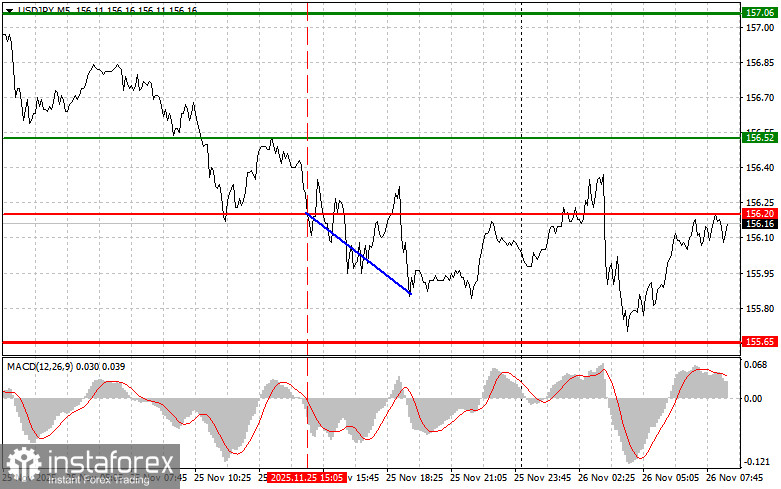Analysis of Trades and Trading Tips for the Japanese Yen
The price test at 156.20 coincided with the moment the MACD indicator just began its downward movement from the zero mark, confirming the correct entry point for selling the dollar. As a result, the pair declined by 20 pips.
Unfavorable macroeconomic data coming from the United States negatively impacts the American currency, weakening its role as a reliable safe-haven asset against the Japanese yen. Investors are concerned about a potential slowdown in U.S. economic growth—especially given the Federal Reserve's cautious stance. External factors are also putting additional pressure on the dollar's exchange rate. In the short term, the dollar's trajectory against the yen will be determined by a range of factors, including upcoming economic indicators and central bank decisions. Traders and investors need to closely monitor these events to make informed decisions. In any case, the trend of yen weakness persists, and with new indicators to stimulate the Japanese economy from the new government, the USD/JPY pair is likely to resume its upward trajectory.
Regarding the intraday trading strategy, I will focus more on implementing scenarios №1 and №2.

Buy Scenarios
Scenario #1: I plan to buy USD/JPY today when the entry point reaches around 156.33 (green line on the chart), with a target at 157.06 (thicker green line on the chart). At the 157.06 level, I intend to exit the long positions and open shorts in the opposite direction (anticipating a 30-35-pip move in the opposite direction from the level). It is best to resume buying the pair during corrections and significant pullbacks in USD/JPY. Important! Before buying, ensure that the MACD indicator is above the zero mark and just starting to rise from there.
Scenario #2: I also plan to buy USD/JPY today if there are two consecutive tests of 156.02 when the MACD indicator is in the oversold area. This will limit the pair's downward potential and lead to a market reversal upwards. A rise to the opposite levels of 156.33 and 157.06 can be expected.
Sell Scenarios
Scenario #1: I plan to sell USD/JPY today only after the 156.02 level (red line on the chart) is updated, which will trigger a quick decline in the pair. The key target for sellers will be the 155.32 level, where I intend to exit the shorts and open immediate longs in the opposite direction (anticipating a 20-25-pip move in the opposite direction from the level). It is better to sell as high as possible. Important! Before selling, ensure the MACD indicator is below the zero line and just starting to decline.
Scenario #2: I also plan to sell USD/JPY today if there are two consecutive tests of 156.33 while the MACD indicator is in the overbought area. This will limit the pair's upward potential and lead to a market reversal downwards. A decline to the opposite levels of 156.02 and 155.32 can be anticipated.

What the Chart Shows:
- Thin Green Line: Entry price for buying the trading instrument.
- Thick Green Line: Estimated price where Take Profit can be set or where profit can be secured, as further increases above this level are unlikely.
- Thin Red Line: Entry price for selling the trading instrument.
- Thick Red Line: Estimated price where Take Profit can be set or where profit can be secured, as further decreases below this level are unlikely.
- MACD Indicator: When entering the market, it is important to be guided by the overbought and oversold zones.
Important: Beginner traders in the Forex market must be very cautious when making trading entry decisions. It is best to remain out of the market before the release of important fundamental reports to avoid getting caught in sharp price fluctuations. If you decide to trade during news releases, always set stop orders to minimize losses. Without setting stop orders, you can quickly lose your entire deposit, especially if you do not use money management and trade with large volumes.
And remember that successful trading requires having a clear trading plan, similar to the one I presented above. Spontaneous trading decisions based on the current market situation are inherently a losing strategy for intraday traders.





















